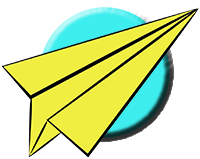Cool Antelope Paper Airplane
Cool Antelope Paper Airplane
Instructions
This litle airplane requires one half of a square sheet of paper. It works best with light to medium weight. Cut a square sheet exactly in half.
1. Bring the upper left corner down and over to the right edge of the paper. The top edge should lie along the right edge of the paper exactly. Unfold after making a tight crease.
2. Repeat on the right. Bring the upper right corner down and over to the left edge of the paper. The top edge should lie along the left edge of the paper exactly. Unfold after making a tight crease.
3. Turn the paper over keeping the creases just formed near the top end
4. Bring the top edge down so the corners meet the point where the diagonals hit the edges of the paper. The new crease should exactly intersect the point where the diagonals cross. Unfold after making a tight crease.
5. Turn the sheet ove again keeping the creases toward the top end.
6. Bring up the two points where the last crease formed meets the edges. This pulls the triangles in and down and forms a flap which stands straight up.
7. Position the paper to work on the right side.
8. Create a typical paper airplane crease by bringing the right diagonal edge over to the center line. It may be more convenient to lay the vertical flap down while making this crease nice and tight.
9. Do the same again by bringing the diagonal edge just formed over to the center line. Make the crease as tight as possible.
10. Open the flap just formed out to the right. This new crease should run from the base of the vertical flap all the way to the lower right corner.
11. Reposition the paper to repeat the last three folds on the left side.
12. Create a typical paper airplane crease by bringing the left diagonal edge over to the center line. It may be more convenient to lay the vertical flap down while making this crease nice and tight.
13. Do the same again by bringing the diagonal edge just formed over to the center line. Make the crease as tight as possible.
14. Open the flap just formed out to the left. This new crease should run from the base of the vertical flap all the way to the lower left corner.
15. Turn the plane over and position it so the square flap is downward.
16. Fold the plane in half by bringing both wings up and forming the center line crease. Line up all the edges before making the crease.
17. Turn the plane over again and position it so the nose is toward the left and the square flap is toward the top.
18. Bring the upper left corner of the square flap over and down to form a new crease. The left edge of the square flap should end up in line with the body of the plane.
19. Unfold the crease just made.
20. Position the plane to work on the square flap and the crease just formed
21. Open the square flap and bring it down and around the nose section of the plane. Make sure that the new crease is used and not the earlier diagonal crease. On one side of the flap the new crease will have to be reversed.
22. Reposition the paper and make sure your model looks similar to what is shown. Fold the top part of the flap which is above the body of the plane down to form a new crease. Unfold when the crease is tight.
23. Open the plane and adjust all the angles so they are even. Set the dihedral angle upward and make sure the wing flaps are angled upward as well.
